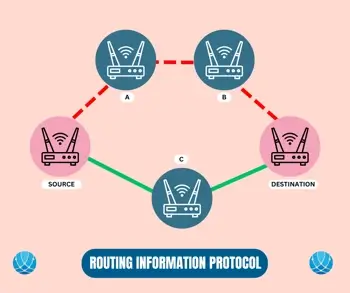What Is Routing Information Protocol (RIP)?
In computer networks, efficient data routing is crucial for seamless communication. But how do routers determine the best path for sending information across vast networks? Routing Information Protocol (RIP) plays a significant role in how data finds its way. Learn what RIP is, how it works, and its benefits in a routing environment.
What is Routing Information Protocol?
The Routing Information Protocol (RIP) is a distance vector routing protocol that enables routers to determine the best paths to send data across a network. It operates on the application layer of the OSI model.
The protocol utilizes a concept known as "hop count" to measure the distance between routers. Each time the data passes through a router, it counts as one "hop." The maximum number of hops allowed in RIP is 15. If data needs to travel further than that, it won't be able to reach its destination using RIP.
RIP is an older protocol; it was first developed in the early 1980s as a part of the Xerox Network Systems protocol. In 1988, it became an official standard.
Even though more modern technologies for Internet routing have overshadowed it, Routing Information Protocol's simplicity remains its strength in smaller environments. For more complex networks, use other protocols like OSPF (Open Shortest Path First) instead, as these newer protocols better handle large amounts of data and more routers.
How does Routing Information Protocol work?
RIP uses Distance Vector Routing to send a data packet to its destination. Each router using RIP has a routing table that maintains a table of destinations and how far away they are.
Routers share their routing tables with neighboring routers every 30 seconds. This update helps routers stay up-to-date on the best paths to take.
When a router receives an update, it checks if any of the new routes are better than the ones it already knows. If a route has fewer hops, the router will update its table to reflect this new information.

The RIP protocol has a limit. It only allows up to 15 hops to a destination. If a route requires more than 15 hops, it is considered unreachable. This keeps the protocol simple and avoids excessive processing on the router.
RIP also has a built-in timer to ensure the network stays accurate. If a router hasn’t heard an update for a specific route in 180 seconds, it assumes the route is no longer valid. It removes the route from its table and then informs neighboring routers, allowing them to update their tables as well.
RIP becomes less efficient as the network grows. Large and complex networks use other routing protocols, such as OSPF or EIGRP.
Features of RIP
Routing Information Protocol (RIP) is equipped with several features that make it a practical choice network.
- Hop count metric. RIP uses hop count to measure the distance between routers. Each hop represents one step in the path, and RIP limits this to 15 hops to avoid routing loops and control network size.
- Periodic updates. Every 30 seconds, RIP routers share their routing tables with neighboring routers to keep the network information current. This ensures that the routers always have the latest information about the network.
- Simple configuration. Many know RIP for its simple configuration. In addition to easy setup, it doesn’t require a lot of technical knowledge. You’ll encounter its deployment in smaller organizations that do not need complexity.
- Compatibility with IPv4 and IPv6. As the internet grew, RIP adapted to newer technologies. RIP version 2 supports IPv4, and RIPng (RIP next generation) works with IPv6.
- Classful and classless support. While RIP version 1 didn't support subnetting (classful), RIP version 2 allows for better use of IP addresses through classless inter-domain routing (CIDR) to optimize network addressing.
Each of these features makes RIP an effective routing protocol.
Key components of RIP
RIP uses a couple of components to achieve efficient route distribution over a network. They include the following:
Routing Information Base (RIB)
The Routing Information Base (RIB) is also called the routing table. It lists information on all the possible routes to different destinations.
Each route has details like the destination address, how many hops it takes to get there, and which router to send the data to next.
Routers update the RIB to reflect this information as they discover new routes. When a route becomes unavailable, it's removed from the map so the router doesn’t try to use it.
Routing updates
RIP routers send updates regularly - usually every 30 seconds - to share information about their current routes with neighboring routers. These updates include the full list of routes that the router knows about so other routers can check if they have better routes.
Network routers use information in these updates to adjust their own routing tables. Keep in mind these updates are sent in a broadcast or multicast format so that all nearby routers can receive them.
Metric calculation
RIP uses “hop count” to measure the best route. Each router in the network counts as one hop. The hop count determines the most efficient path for sending data. If there are multiple ways to reach a destination, RIP will choose the route with fewer hops.
Routing tables
Networkers update routing tables via a distance-vector algorithm. When a router gets a new routing update, it compares the hop counts of the new routes with the hop counts in its own table. This process ensures that routers always have the best route.
Routing loop prevention
One of the challenges of using distance-vector protocols like RIP is the possibility of creating "routing loops." A routing loop occurs when routers keep sending data in a circle, never reaching the destination.
RIP uses either the split horizon or the poison reverse method to avoid this. A split horizon prevents a router from sending information back to the router from which it received it.
With the second method, if a router learns that a route is no longer valid, it will immediately advertise the route as having an infinite hop count (usually 16).
Types of Routing Information Protocol timers
RIP (Routing Information Protocol) utilizes several timers to regulate the frequency of router-to-router information exchange. The update timer, invalid timer, hold down timer, and flush timer all have some type of control over routing procedure.
- Update timer controls how often routers send out their routing tables to neighboring routers. By default, this timer is set to 30 seconds. For every 30 seconds, a router broadcasts its current routing table to its neighbors.
- Invalid timer controls the validity of routers based on updates. If a router receives no updates about a route for 180 seconds, it considers that route invalid. The invalid timer tells the router to mark the route as unreachable by setting the hop count for that route to 16. This hop count of 16 is treated as "infinity" in RIP.
- Hold down timer is set to 180 seconds by default. If a route receives an invalid mark, the router waits for this timer to expire before accepting any new updates for that route.
- Flush timer is the final step in removing an invalid route from the router’s table. Once a route has been declared invalid (after the invalid timer has expired), the router will wait an additional 60 seconds (the flush time) before completely deleting the route from its table. So, in total, a route will be fully removed after 240 seconds.
Routing Information Protocol versions
The Routing Information Protocol (RIP) has three main versions: Routing Information Protocol version 1, Routing Information Protocol version 2, and Routing Information Protocol next generation. Each version should, in theory, improve upon the last.
RIPv1
RIPv1 was the first version, introduced in 1988. As a classful routing protocol, it doesn’t send subnet mask information with its routing updates. It assumes all networks use default subnet masks based on their class (A, B, or C). RIPv1 also broadcasts its routing updates to all devices on the network.
RIPv2
RIPv2, developed in 1998, overcomes many of RIPv1’s limitations. It’s a classless protocol, meaning it includes subnet mask information in routing updates. RIPv2 can support Variable Length Subnet Masking (VLSM) to allow networks to use more customized subnetting.
This version also uses multicasting to send routing updates compared to RIPv1’s broadcast method.
Equally important, RIPv2 comes with authentication features to prevent unauthorized routers from injecting incorrect information into the network.
RIPng
RIPng (Routing Information Protocol next generation) is an extension of RIPv2 that was developed to support IP version 6. The technology was created to handle the larger address space and other features unique to IPv6.
RIP message format
RIP facilitates the exchange of routing information among routers using a well-defined message structure. This format organizes the data in a way that routers can understand. The RIP message consists of several key fields.
- Command: An 8-bit field that indicates whether the message is a request (value 1) or a response (value 2).
- Version: Specifies the version of the RIP protocol used (e.g., 1 for RIP version 1).
- Reserved: A field filled with zeros, reserved for future use.
- Family: A 16-bit field that identifies the protocol family. This is set to 2 for the TCP/IP family for RIP.
- Network address: A 14-byte field that defines the destination network address. For IPv4, the field uses only 4 bytes, with the remaining 10 bytes set to zero.
- Distance: Indicates the hop count or how many routers (hops) the path to reach the destination network requires.
All of these fields work together to create a cohesive, comprehensive message for routers to receive.
Benefits of RIP
RIP is an easy-to-configure protocol that's excellent for smaller network users because of its ease. In addition, it automatically updates routing tables to reduce the need for manual intervention. Its simplicity overall allows for quick troubleshooting and maintenance.
The Routing Information Protocol by definition is a standard protocol. This means that many different router brands support it, making it beneficial for networks. It also helps prevent routing loops with features such as Split Horizon and Poison Reverse. All of these features make it a great choice for network users still learning their way around protocols and systems.
Limitations of RIP
Like all protocols, Routing Information Protocol presents some limitations. For one, the protocol generates more traffic when it sends regular updates to neighboring routers, which can cause network congestion. Furthermore, it's unsuitable for large-scale networks with a maximum hop count of 15.
The protocol also does not always choose the most efficient path, as it only considers hop count and ignores other factors such as link speed.
Frequently asked questions
How is RIP configured on a router?
You configure RIP on your router by accessing the command-line interface (CLI). Enable RIP with the router rip command, and specify the networks you need to include using the network command. You can also configure additional settings like RIP version and authentication based on the network’s needs.
What are the functions of a RIP message?
RIP message shares information among different routers.
What are the vulnerabilities of RIP?
Security concerns include its lack of robust authentication, susceptibility to routing table manipulation, and inefficiency in large networks due to its limited hop count.

